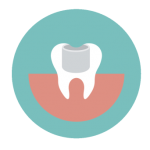Dental implants are used to anchor a single tooth, several teeth or a mouthful of teeth. As the accompanying illustration shows, the typical dental implant for the replacement of a single tooth consists of three separate pieces; each fulfilling a unique role in the process. The actual implant is usually a titanium screw that is surgically placed in the jawbone. Over the next 4 to 6 months, the implant will safely fuse with the jaw bone to form a secure, immovable base upon which the two other components, the abutment and the prosthesis (crown, bridge, or other attachment) will be placed. The abutment attaches to the portion of the implant that is below the gum line. It forms a platform for the crown, which is carefully molded and positioned on the abutment by a restorative dentist. Think of it like nesting dolls, one part nested on top of the other.
In general, the crown is not added until the implant and jawbone have fused. There are some cases, particularly in situations where there is an aesthetic concern, when a temporary crown may be placed on the abutment at the time of surgery. One of our surgeons can tell you if this procedure is right for you.
All For One and One For All
If you are replacing several teeth in the same area or a mouthful of teeth, your surgeon may place two or more implants to securely anchor a fixed or removable prosthesis. These prostheses anchor to the implants to form a stable, immovable bond that allows the patient to speak clearly, eat normally, and smile freely — just as if he or she had natural teeth.
The Dental Implant Procedure is a Team Effort
The dental implant procedure is a team effort that includes the patient; the oral and maxillofacial surgeon, who surgically places the implant; and the restorative dentist, who creates and places the crown after the site has healed and coordinates the various aspects of the procedure.
Who Needs Implants?
With the general exception of growing children, dental implants can improve the quality of life for almost everyone who is missing one or more teeth. People of all ages can benefit from dental implants.
The Huntington Group has successfully treated many patients in their 80’s and 90’s with dental implants. Additionally, individuals with existing medical conditions or other health concerns, including the following, are generally good candidates for implants.
- Medical Conditions – If you can have routine dental treatment, you can usually have an implant placed. While precautions are advisable for certain conditions, even patients with chronic illnesses, like diabetes, are generally candidates for implant treatment provided that the disease is well controlled.
- Gum Disease or Problem Teeth – Implants have been placed with high success rates in patients who have lost their teeth to periodontal
(gum) disease or decay. However, the patient must understand that although implants cannot get cavities, implants can have bone loss just like natural teeth if they are not maintained well. - Currently Wearing Partials or Dentures – Dental implants can replace fixed bridges or removable dentures, or they can be used to stabilize and secure removable dentures, making them much more comfortable.
- Smokers – Although smoking lowers the success rate of implants, it doesn’t necessarily eliminate the possibility of getting them. It is a known risk, however often they are still successful.
- Bone Loss – Bone loss is not uncommon for people who have lost teeth or had periodontal disease. Your surgeon can discuss the options available for you in replacing missing bone should it be needed to safely and securely place the dental implant.
Implant tooth replacement in children is usually deferred because their jawbones are still growing and the implant, a fixed entity, will not grow with the bone. There are exceptions, however, and some children, such as those undergoing orthodontic procedures, may be candidates for dental implants. Your family dentist or orthodontist will help you determine whether dental implants are right for your child.
Benefits of Dental Implants
If you are unfamiliar with dental implants or maybe thought they were similar to traditional fixed bridges and removable dentures, you may be surprised by their unique quality of life benefits. Dental implants look, feel and perform like your healthy, natural teeth. They help protect your oral health by reducing the bone loss that often accompanies the use of conventional dentures that rest on the gum line. Dental implants enable you to eat and enjoy the foods you crave without restriction and allow you to speak clearly and confidently without embarrassing clicking noises or slipping dentures.
- Implants Aid in the Prevention of Bone Loss – The density of the jawbone is preserved and maintained by the presence of your natural teeth. When one or more teeth are lost through gum disease, tooth decay, an accident or other incident, the bone thins and weakens over time. In the area of the missing teeth, both fixed bridges and removable dentures rest on top of the gum line and do nothing to maintain or preserve the jawbone. As bone loss occurs, the fixed bridge or removable denture no longer fits properly. Patients with fixed bridges may encounter hygiene problems commonly associated with these prostheses, while patients with removable dentures may be bothered by clicking noises and slippage of their dentures. Dental implants, however, are placed into and fuse with the jawbone to form a long lasting bond that maintains and preserves bone density in the same manner as healthy, natural teeth.
- Avoids Injury to Adjacent Teeth – Until the advent of dental implants, a fixed bridge was the conventional solution for replacing a single missing tooth. Unfortunately, a fixed bridge designed to replace one tooth actually impacts three teeth; the tooth being replaced and the teeth on either side, which are used to anchor the bridge. These adjacent teeth must be cut down so the bridge may be securely cemented. Because the dental implant is fused with the jawbone, it is a free-standing restoration and the need to disturb the adjacent teeth is avoided.
- Lifestyle Benefits – Insecure fit, difficulty eating favorite foods and an artificial appearance often cause patients who wear removable dentures or fixed bridges to complain that the appliances make them look and feel older than their actual age. By contrast, natural looking, long-lasting dental implants are usually indistinguishable from natural teeth and provide patients with more self-assurance and confidence.
Dental Implants. Of all the options open to the patient, dental implants are frequently the best treatment option and the solution of choice for replacing missing teeth. Implants do not impact adjacent teeth or lead to bone loss. In general, dental implants seldom need replacement once they have fused with the bone.




